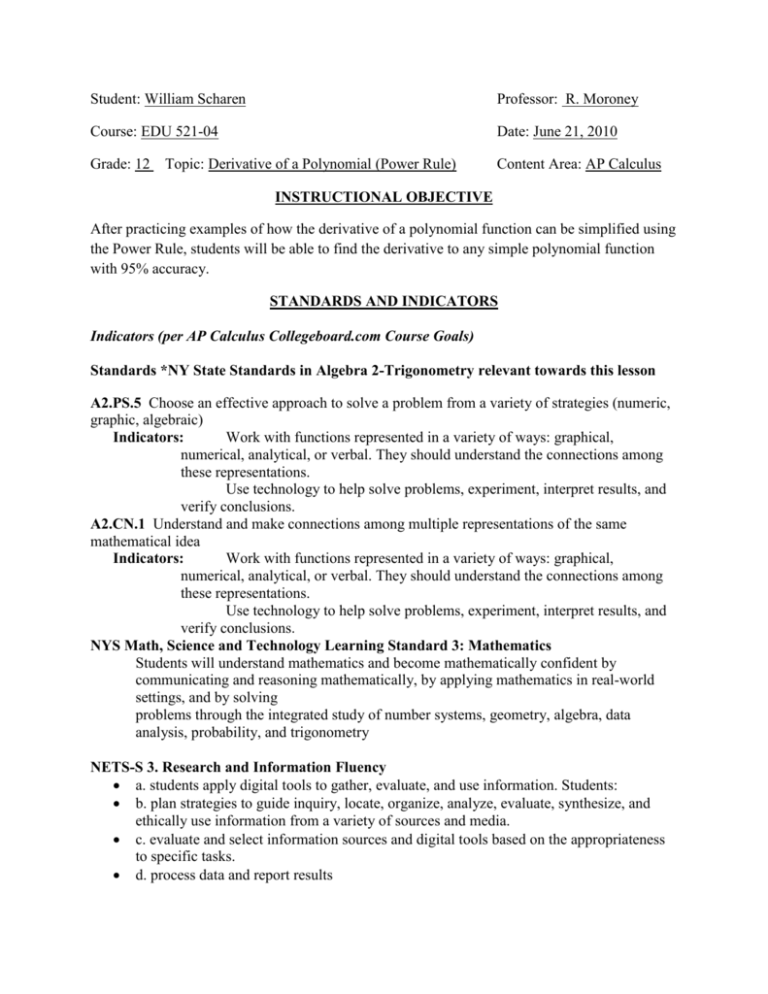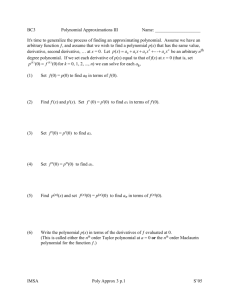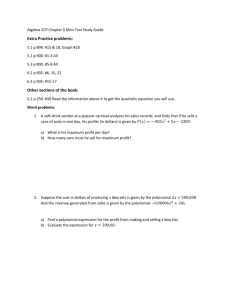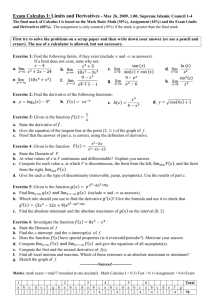File - CALCULUS, BABY, CALCULUS!!!
advertisement

Student: William Scharen Professor: R. Moroney Course: EDU 521-04 Date: June 21, 2010 Grade: 12 Topic: Derivative of a Polynomial (Power Rule) Content Area: AP Calculus INSTRUCTIONAL OBJECTIVE After practicing examples of how the derivative of a polynomial function can be simplified using the Power Rule, students will be able to find the derivative to any simple polynomial function with 95% accuracy. STANDARDS AND INDICATORS Indicators (per AP Calculus Collegeboard.com Course Goals) Standards *NY State Standards in Algebra 2-Trigonometry relevant towards this lesson A2.PS.5 Choose an effective approach to solve a problem from a variety of strategies (numeric, graphic, algebraic) Indicators: Work with functions represented in a variety of ways: graphical, numerical, analytical, or verbal. They should understand the connections among these representations. Use technology to help solve problems, experiment, interpret results, and verify conclusions. A2.CN.1 Understand and make connections among multiple representations of the same mathematical idea Indicators: Work with functions represented in a variety of ways: graphical, numerical, analytical, or verbal. They should understand the connections among these representations. Use technology to help solve problems, experiment, interpret results, and verify conclusions. NYS Math, Science and Technology Learning Standard 3: Mathematics Students will understand mathematics and become mathematically confident by communicating and reasoning mathematically, by applying mathematics in real-world settings, and by solving problems through the integrated study of number systems, geometry, algebra, data analysis, probability, and trigonometry NETS-S 3. Research and Information Fluency a. students apply digital tools to gather, evaluate, and use information. Students: b. plan strategies to guide inquiry, locate, organize, analyze, evaluate, synthesize, and ethically use information from a variety of sources and media. c. evaluate and select information sources and digital tools based on the appropriateness to specific tasks. d. process data and report results NETS-S 4. Critical Thinking, Problem Solving, and Decision Making Students use critical thinking skills to plan and conduct research, manage projects, solve problems, and make informed decisions using appropriate digital tools and resources. a. identify and define authentic problems and significant questions for investigation c. collect and analyze data to identify solutions and/or make informed decisions MOTIVATION To express any given polynomial as a car’s speed as a function of time, students will be shown on Google Earth the Autobahn highway in Germany, watch a 5 minute video on YouTube of a person going various speeds. The purpose is to demonstrate his speed and distance as a function of time. These ties in with the lesson of simplifying how to find the derivative of a simple polynomial function. MATERIALS Computer Projector Smart Board Smart Notebook Inspiration Software Microsoft PowerPoint Google Earth You Tube Virtual TI-84 Software Textbooks Notebooks Pens/Pencils iTunes - Podcast STRATEGIES Direct Instruction Open discussion Problem solving – Inductive Thinking/Learning - PBL (Problem-based learning) Group work – Listen, Think, Pair and Share Carolina Teams Improvement ADAPTATIONS The student who has a learning disability in note-taking will have a copy of the day’s notes The student who is an ELL will be provided with pertinent vocabulary words prior to the lesson The student who is mathematically gifted will be given the opportunity to use an overhead calculator (Virtual TI-84 Software) to illustrate a numerical or graphical concept DIFFERENTIATION OF INSTRUCTION The teacher believes that all students deserve the right to an education The teacher acknowledges that not every student learns the same way The teacher confirms that multiple methods will be used for instruction to engage multiple intelligences The teacher is aware that while this is a college-based course, students with special needs will be given a fair opportunity to excel in this class. DEVELOPMENTAL PROCEDURES Activities The teacher will briefly explain that functions in math can model measuring real life situations. The teacher will speak about a function could be a car’s speed/distance over time. The teacher, after briefly asking if anyone knows what the Autobahn is, quickly explains/introduces the video, making sure the computer and projector are already turned on, and then play the YouTube video of the Autobahn. Key Questions to ask (after the video is played) What was the fastest speed the Lamborghini went? At a rate of 189mph, was he consistently going that fast? What about 174mph? How could we graph these speeds over the timeframe of the video? The teacher calls upon students to break into groups of 2-4 and do their best to represent his speed over the time of the video. This should take 5 minutes. A representative from each group will try to re-create their group graph on the SmartBoard using the SmartNotebook files. Teacher may show attached SmartNotebook file as example to better represent the questions being asked Teacher will show how a polynomial function can be represented as the speed of the Lamborghini over a function of time. The teacher will show the students on the SmartBoard the Power Rule of finding a derivative; relating it to the instantaneous rate of change of the car’s speed f(x) at any instantaneous given time (x). Students will be shown three example of how to obtain the derivative of a polynomial function via Power Rule. Students will be given three to five examples to work in groups for the remaining five minutes of class and asked to find the derivatives of these functions using the Power Rule. ASSESSMENT By the end of class, students should be able to identify a polynomial’s derivative using Power Rule INDEPENDENT PRACTICE Students will be given three to five examples to work in groups for the remaining five minutes of class and asked to find the derivatives of these functions using the Power Rule. Upon the conclusion of the lesson, students will be given five to ten examples to continue for homework. FOLLOW-UP: ACADEMIC INTERVENTION AND ACADEMIC ENRICHMENT Upon the conclusion of the lesson, students will be given five to ten examples to continue for homework. Students will be given the iTunes Podcast to listen/watch for further explanations of the last two lessons if they would like a challenge; they may construct examples on their own to find the derivatives and bring in the next day for a bonus three points on their next quiz. The team of students who get the most extra questions correct will be awarded these bonus point. TEACHER REFERENCES Hughes-Hallett, Deborah, Gleason, Andrew, & McCallum, William, (2009). Calculus: Single Variable, (5th ed.). New York, NY; Wiley & Sons Publishing. Driving Lamborghini on Autobahn at 305kph=189mph We rented a Lamborghini Gallardo & Porsche 911 for incredible fun on Autobahn in Germany. What a way to end a two week Europe vacation! Footage: airjersti, May 8, 2007 http://www.youtube.com/watch?v=sYPCLtA-ETk Jerison, David. (Teacher). (2007, Fall). MIT Open Courseware.[MIT 18.01]. Single Variable Calculus: Lecture01: Derivatives, slope, velocity, rate of change. Podcast retrieved from iTunes








